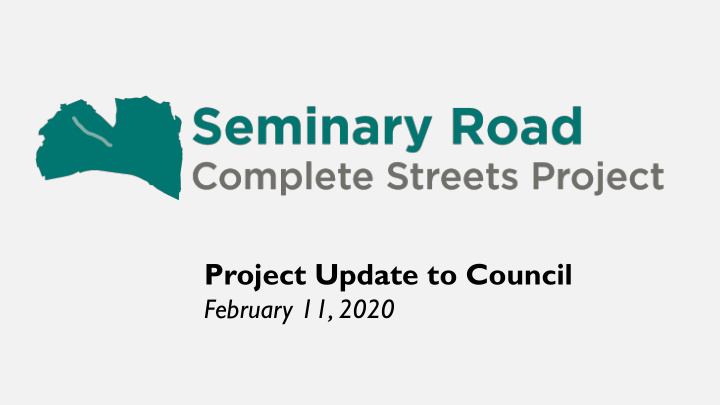



Project Update to Council February 11, 2020
WHAT WE’VE DONE SO FAR October: • Street repaved and striping November: • Signals, signal timing, pedestrian signals, and increased detection • Signage & additional striping • Median islands, crosswalks and rapid flashing beacons • Barrier for in-street shared-use path December: • Final signage, & striping, and flex posts 2
REPORTABLE CRASHES Crash Rate for October 30 - January 10 in prior years Number of reportable crashes 4 2 1 1 0 10/30/15 - 1/10/16 10/30/16 - 1/10/17 10/30/17 - 1/10/18 10/30/18 - 1/10/19 10/30/19 - 1/10/20 3 *Does not include calls for service
PROJECT COST $1,200,000 $1,025,183 $951,091 $1,000,000 $779,683 $800,000 $600,000 $400,000 $200,000 $0 Build No Build + HAWK* No Build Study and Analysis Design Plans Repaving Implementation Data Collection *Staff recommendation to City Council and Traffic and Parking Board Recommendation 4 Note: Costs estimated for categories except Study and Analysis and Repaving categories
COST TO REVERT* • Option 1 – Permanent Restoration: Most thorough & durable $700K • Option 2 – Micro-seal: More economical but maintenance challenges/trade- offs and unclear timeline for durability $500K • Option 3 – Marking eradication & asphalt patching: Most economical but least durable and aesthetically poor. Likely hasten need for full resurfacing in the future. $300K • Median island conversion: Replace two standard islands with mountable islands $40K *High level cost estimates 5
PRELIMINARY TRAVEL & TRAFFIC SUMMARY • Across the day , average travel times have generally stayed the same: • Increased by an average of 4% (6 seconds) in the westbound direction and have decreased by an average of 6% (about 12 seconds) in the eastbound direction • In the eastbound directions, travel times are better or relatively the same as they were during the before period except for the 5pm hour (7% increase or about 6 seconds) • During the worst 15-minute period of the day (in the westbound direction from 8:15am – 8:30am) travel times have increased by 30% (about 1 minute). • Across the entire morning peak period (7am-9am), there has been an 8% increase in travel times from 3 minutes to 3.2 minutes (about 12 seconds) • During the evening peak , the greatest increase was between 5:45pm and 6:00pm when there was a 14% increase, from 3.4 minutes to 3.9 minutes (about 30 seconds) For most of the day, the City’s Bluetooth travel time monitoring system shows the road is functioning similarly to before implementation. A tradeoff for the peak half hour increases (30 sec – 1 minute) is a street with safer conditions for people who drive, walk, bike and use transit.
PEAK TRAVEL TIMES Minutes ~1 minute ~30 sec Minutes BEFORE = Sept 24 – Oct 10, 2019 DURING (Construction) = Oct 14 – Nov 21, 2019 AFTER = Dec 3, 2019 – Jan 30, 2020 Data collection for T, W, Th only – does not include holidays, when school is not in session or weather events 7
ALL DAY TRAVEL TIMES Minutes Minutes Minutes BEFORE = Sept 24 – Oct 10, 2019 DURING (Construction) = Oct 14 – Nov 21, 2019 AFTER = Dec 3, 2019 – Jan 30, 2020 Data collection for T, W, Th only – does not include holidays, when school is not in 8 session or weather events
EMERGENCY ACCESS Mountable Median Standard Crossing Median Why were two different medians constructed? • Mountable medians were installed in conjunction with the temporary sidewalk so vehicles would not have to pull into the sidewalk space to let an emergency vehicle (EV) pass, and the EV could go directly over the median • Standard crossing medians were installed where vehicles can pull out of the travel lane and into the bike lane to allow EV to pass. • Medians were designed cooperatively between T&ES and AFD • Appropriate measures have been put in place for emergency responders to safely travel before, 9 during and after an emergency call
EVALUATION • Volumes* • Crashes* • Speeds* • Travel Times AFTER Data Collection (Spring 2021) Evaluation Report (June 2021) 10 *Data for Seminary Road and neighborhood streets
PATRICK HENRY SWING SPACE AND DMES • Traffic Study by ACPS for the Patrick Henry Swing Space used for Douglas MacArthur considered: • Normal mode split for the school • Six additional buses for MacArthur students • Distribution of trips, the projected additional trips within the Seminary Road and N. Jordan Street intersection • Findings: approximately 60 trips in the AM peak hour and 20 trips in the PM peak hour. • This results in a continued acceptable LOS for both AM and PM peak hours
QUESTIONS 12
Recommend
More recommend